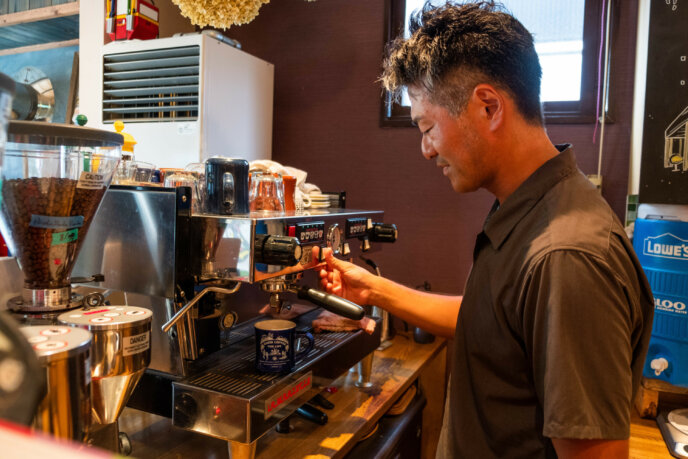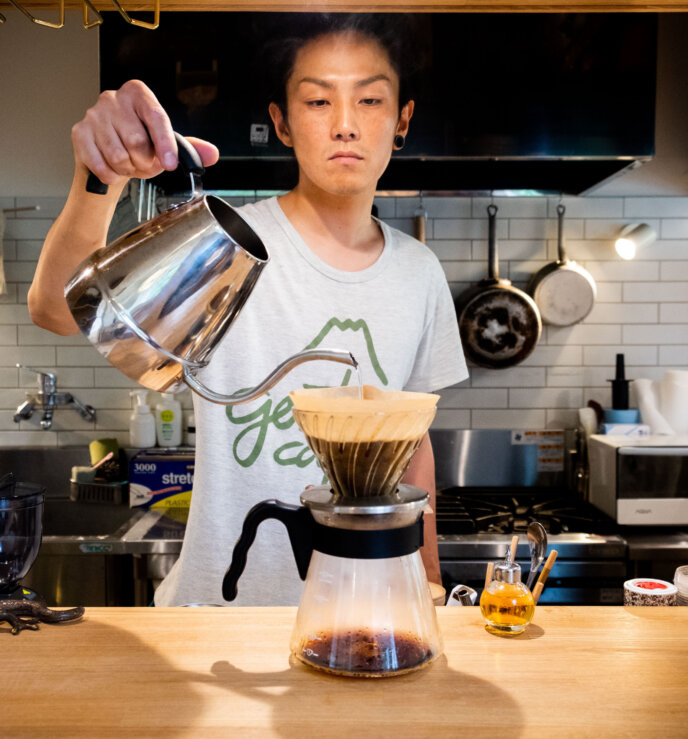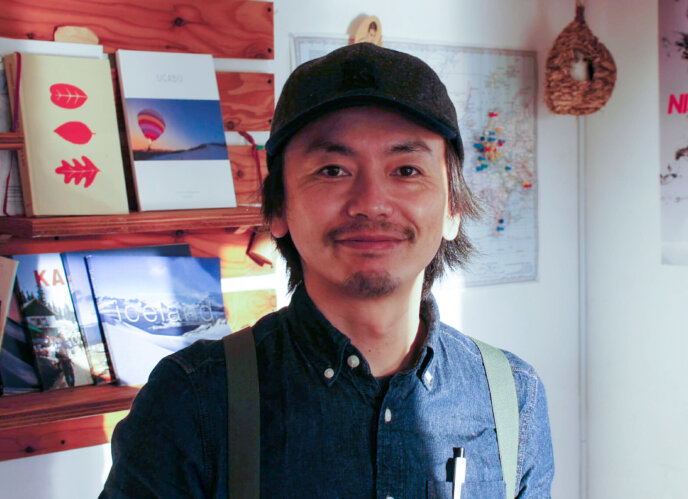Coffee Culture
We interview four founders of the Niseko coffee scene who utilise this beverage to enhance community ties, promote the beauty of the natural Niseko landscape, provide comfort and vitality and share love with all.
Coffee has a long and illustrious history in Japan. First introduced in the late 1800s by the Dutch and then popularised after World War II, Japan’s insatiable interest in all things western led to coffee being imported at an astounding rate. During the 20th Century, traditional Japanese coffee and tea houses or ‘kissatens’ began perfecting the art of single cup brewing and the pour over method.

Soon Japanese cafes were sourcing single origin beans and roasting in-house. Combining fresh roasted beans with the art of pour over coffee meant the Japanese were soon creating some of the best coffee in the world. This holds true in Niseko.
Niseko is at a crossroads of international cultures. At this intersection we find an explosion of variety and taste. We sit down with four of the pillars of the Niseko coffee landscape and hear about their stories.
Graubünden

Since December 1990, Junko Watanabe has operated her Swiss-German styled café, Graubünden, which is named for the region in eastern Switzerland that contains Kutchan’s sister city St Moritz. Jun spent much of her youth travelling the world and learning about the hospitality of other cultures and the décor at Graubünden demonstrates Jun’s worldly sensibilities. In the end the allure of her hometown was too hard to resist; a close-knit community, nature, great produce and the best powder in the world.
In Graubünden, Jun wanted to provide a location where customers felt like they were at home. She wanted to create a location where they could fuel up on good food and coffee before a long day on the mountain or relax by the fire with a cappuccino after a cold day on the slopes. Blessed with an unparalleled vibrance and energy, Jun set about materialising her vision.
Being the cosmopolitan that she is, Jun thrives in the Niseko environment, this area is a true melting pot of international cultures. With so many people and tastes converging on this small-town, Jun recognises the importance of creating a great, balanced cup of coffee.
“Coffee in Hirafu is made at a very high level,” Jun explains. “Niseko probably has the most semi-auto espresso machines in the whole of Hokkaido!” Jun sources the beans used for Espresso from a special Seattle provider, chosen for their perfect balance of sweet and sour. For blend coffee she utilises organic beans to provide full body and rich taste. Her favourite drink is a cappuccino topped with an expertly foamed cream. What makes it even more special is when she can enjoy it at Graubünden near the fireplace after a long day skiing.
Sprout Outdoor Espresso

A place locals can meet to talk about their passions and connect with one another. This was the dream of Yoshitaka Toge and wife Yukiko when creating Sprout Outdoor Espresso. The iconic Kutchan café will celebrate its 10th birthday in December 2019.
The seed for this idea took root in Yoshi’s mind during a trip exploring the Alaskan wilderness. During transit in Seattle he was amazed at the café culture. He witnessed communities of passionate individuals congregating at their favourite cafés to discuss their pursuits. He wanted to replicate this atmosphere.
Yoshi and Yukiko went about making their ‘Outdoor Café’ dream come alive. The family moved from Chiba prefecture with Yoshi working for Niseko Adventure Centre for five years. The family was finally able to open Sprout in 2009 and have been reaping the fruits of this creation ever since. Sprout has become a home for many mountain-minded individuals, meeting at the store to enjoy a hot brew and discuss the outdoors.
Sprout have been roasting their own beans for the last four years, a decision Yoshi made to improve his ability to adapt and adjust his offering for different seasons and tastes. Along with a great selection of single origin beans, Yoshi also creates two of his own blends. The all year appropriate Mt. Yotei Blend, and the summer special, Niseko Haute Route.
Yoshi is partial to both espresso and drip coffee and his favourite beans are from Ethiopia - he describes the results as ‘kirei’- sharp, clear and light.
Sprout is still in its growing phase. Yoshi and Yukiko are constantly learning, adapting and transforming themselves and their beloved café. It is an organic space, a living, breathing entity that has become home to many a trail runner, mountaineer or skier. If it’s the outdoors you love, you will find no better place to visit than Sprout Outdoor Espresso.
Gentem Café

Located in quiet Kabayama, away from the hustle and bustle of Hirafu, is the Gentemstick headquarters. This timber and glass temple, an artwork in itself, is the spiritual home of the snow-surf movement and snowboarding in Niseko.
The Gentemstick snowboards lining the walls of the showroom are religious relics, snow-sticks handed down by the mountain gods. There is no better way to spend an afternoon than to enjoy a coffee in the upstairs Gentem Café and ruminate on the artisanal nature of these creations and ponder the icy origins of snow-surf.
The Gentem crew behind the café counter, under the guidance of their patron saint, Taro Tamai, extend their master craftsmanship to this humble beverage. Paying homage to the traditional Japanese kissaten, the Gentem Café specializes in slow drip coffee. Espresso is expressly forbidden.
In his youth Taro Tamai would drink and practice this style of coffee, making regular stops at Café Haiti in Shinjuku. It is from this café that Gentem now sources their coffee beans. These dark, flavourful beans are paired with the purest of spring waters sourced directly from the Kanro spring at the base Mt. Niseko-Annupuri; the mountain that inspired Taro to move to Niseko and birth the phenomenon that is snow-surf. It is also interesting to note that Emperor Showa visited this spring and pronounced its flavour sweet and soft.
A mainstay coffee craftsman at Gentem Café, Ryoma Kohinata, told us as we were enjoying our fresh brew that coffee was an essential part of his morning, whether he was surfing in the summer or snowboarding in the winter. We couldn’t agree more. There are few places in Hirafu where you can enjoy this elixir of life and be surrounded by powerful art and cultural artefacts. So, make the trip to this place of worship.
Mountain Kiosk

Ihara Hiromasa was born in Kutchan in the early 1980s and quickly found success as a self-taught snowboarder. It was inevitable that he would soon be competing on the world stage. Competition however would not remain his number one priority and his focus shifted to creating epic visuals in photos and on film, the mountains his canvas.
Frequently visiting the US to snowboard, Ihara would seek out great coffee before riding each morning. He would soon draw parallels between the artforms of coffee making and snowboarding - both filled with beauty and free expression. He became enamoured with this worldly tonic and dedicated himself to its mastery.
In 2014 the Mountain Kiosk was born and it was in this setting that Ihara could truly express his coffee vision. Being located at the Welcome Centre, the kiosk provides caffeine comfort to both new arrivals and those tired bodies leaving for home. More importantly it provides boarders and skiers easy access to this wonder fuel before they set off on the quad chair towards the peak or for those in need of a mid-session rejuvenator.
Ihara takes the remedial nature of his beloved coffee seriously and as such is committed to providing the most exceptional brew. The Mountain Kiosk uses specialty beans that are roasted daily by close partners, Takano Coffee from Arishima. “They allow us to change our roast and blend based on temperature and weather conditions in an instant,” Ihara explains thankfully.
Whether he is making espresso at the Mountain Kiosk or Drip Coffee at home, he ensures he is in a calm state of mind when practising his art. The combination of world class beans, pure Hokkaido spring water and the deft touch of a master craftsman result in one of the best coffees in Niseko, a coffee that cannot be reproduced anywhere else in the world.
--
Translations: Yuko Miyake, Ami Tomimori & Sirada Tranghiranyatorn
This article first appeared in the 2019/20 Experience Niseko Winter Magazine.
For more amazing Niseko locations head to our Eat & Drink page!
